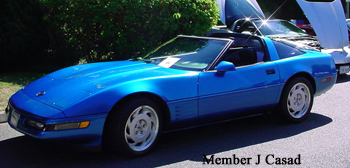As printed in For Vettes Only in October 1991.
 We’ve been applauding Corvette’s solid and indisputable entry into the World Class sporting car market for several years now. With the introduction of the 1992 edition, Corvette further cements its position and perhaps takes yet another step toward the top of the list. An unspoken promise was made with the Vette’s introduction in 1953, and at no time has the glass machine come closer to fulfilling that promise.
We’ve been applauding Corvette’s solid and indisputable entry into the World Class sporting car market for several years now. With the introduction of the 1992 edition, Corvette further cements its position and perhaps takes yet another step toward the top of the list. An unspoken promise was made with the Vette’s introduction in 1953, and at no time has the glass machine come closer to fulfilling that promise.The catch phrases for Corvette in 1992 are “safety” and “all-weather performance.” If either of these at first seem contradictory to your personal image of the Corvette, read on (and maybe go back to driving school too).
The ZR-1 special performance package returns for its third model year, but the biggest news lies in three major features that distinguish the 1992 Corvette. First, there’s a new 350-CID V8 engine – dubbed the “LT1” – that ushers in a second generation of Chevy small-block power. It delivers 300 horsepower at 5000 rpm, the highest net horsepower for any production car small-block in Chevrolet history, over 50 more horses than the L98 engine it replaces. The LT1’s performance equals or exceeds existing world-class V8 engine standards for mass, size, fuel consumption, emissions and cold start.
A sophisticated traction control strategy called Acceleration Slip Regulation (ASR) is designed to work with the existing anti-lock brakes to provide improved acceleration and enhanced vehicle stability in all weather conditions, thus making Corvette a “car for all seasons.” Chevrolet calls ASR one of the most sophisticated traction control system now available. It functionally integrates with three different vehicle systems – engine timing, throttle and brakes – and it’s also calibrated to deliver a full measure of the car’s power to the pavement. ASR is automatically engaged when the vehicle ignition is turned on, but can be disengaged via a push-button on/off switch on the instrument panel when additional wheel slip is desired or when the Corvette becomes mired in snow or mud.
Understanding the Corvette’s ASR system begins by understanding what it isn’t. ASR does not increase the amount of grip available between where the tire makes contact with the road surface. Instead, ASR (or any traction control strategy) is designed to help drivers get the most out of the grip that’s there. The benefits to the driver include increased comfort, reduced anxiety and stable vehicle operation closer to the limit over a variety of road conditions.
Acceleration Slip Regulation (ASR) for Chevrolet’s 1992 Corvette is a system designed to work with the existing four-wheel anti-lock brakes to provide improved acceleration and enhanced vehicle stability in all weather conditions. According to the folks a Chevrolet “Of all of the traction control systems now available, the Corvette ASR system – created by Bosch – is one of the most sophisticated.”
New Goodyear Eagle GS-C high-performance tires are a ’92 Corvette exclusive. The tires have a directional and asymmetrical tread pattern which should deliver superb wet and dry handling performance, wearability, cornering force and noise suppression. Directional means the GS-Cs are designed to rotate in one direction only. They must, therefore, be mounted on only the left or right side of the car. An asymmetrical tread pattern varies from one side of the tire to the other. It took some compromises to create the GS-C but for once, compromise seems to have yielded the best possible result.
That covers the performance end of the ’92 Corvette picture. As usual, however, there are a handful of other enhancements new Vette buyers should find to their linking. Inside the car, the instrument panel has a new black “soft-touch” appearance to improve the driver’s comprehension of the vital information. The most noticeable interior change is the higher placement of the speedometer in the display area. Finally, Corvette gets four new exterior color choices, three new leather interior colors and a new dark blue cloth convertible top.
The rebirth, after 20 years of an LT-1 Corvette – complete with a standard equipment traction control feature and what appear to be some first class new tires – should prove pretty impressive to enthusiasts. “Safety” and “all-weather performance” without giving up any of the things that make Corvette one of the World’s favorite sports car: Time for a trade?